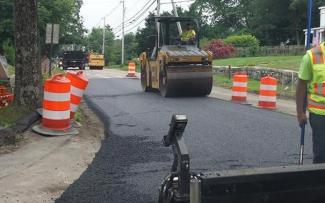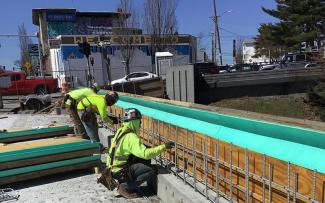Bridge And Pavement Condition
What Do We Measure?
State Departments of Transportation (DOTs) must establish targets, regardless of ownership, for the full extent of the Interstate and non-Interstate National Highway System (NHS). FHWA has set numerical standards that categorize pavement conditions as good, fair, or poor. Pavement in good condition suggests no major investment is needed. Pavement in poor condition suggests that major reconstruction investment is needed. Road pavements are classified as one of three types: concrete, bituminous (also known as asphalt), and jointed concrete—which is a series of contiguous concrete slabs joined together. Pavement condition is determined by specific measures, which include the International Roughness Index (IRI), cracking, rutting, and faulting:

- IRI quantifies how rough the pavement is by measuring the longitudinal profile of a traveled wheel track and generating a standardized roughness value in inches per mile.
- Cracking measures the percentage of bituminous and concrete pavement surface that is cracked.
- Rutting measures the depth of ruts (surface depression) in bituminous pavement in inches.
- Faulting quantifies the misalignment between concrete slabs as the difference in elevation across transverse concrete pavement joints in inches.
Roughness affects travel speeds, safety, comfort, and transportation costs. Cracking, rutting, and faulting are surface indicators of underlying structural deterioration. All three pavement types consider IRI and cracking. Bituminous pavements additionally consider rutting, while jointed concrete also utilizes faulting.
The performance-based planning regulation requires that state DOTs (RIDOT) set two and four-year targets for the percentage of pavement miles that fall into the “good” and “poor” category on the state’s Interstate and non-Interstate NHS. Specific targets are set for:
- Percentage of Interstate Pavements in Good Condition.
- Percentage of Interstate Pavements in Poor Condition.
- Percentage of non-Interstate Pavements in Good Condition.
- Percentage of non-Interstate Pavements in Poor Condition.
State DOTs must establish targets for all bridges carrying the NHS, which includes on- and off-ramps connected to the NHS within a state, and bridges carrying the NHS that cross a state border, regardless of ownership. Each bridge is given ratings for its deck, superstructure, and substructure components during regular inspections using National Bridge Inventory (NBI) standards. Each component is given a rating that ranges between 9 and 0 on the FHWA condition scale. A structure’s overall condition rating is determined by the lowest value for its deck, superstructure, substructure, or culvert rating. If any of the components of a structure qualify as poor, the structure is deemed poor; while all the components must have a good rating for the structure to be deemed in good repair. Poor condition does not mean the bridge is unsafe to use. RIDOT will take necessary action to restrict heavy-weight vehicles or close a bridge in order to ensure safety. Bridge condition performance measures are calculated by summing the deck area of bridges in “good” and “poor” condition and dividing by the total deck area of all NHS bridges.
Bridge deck conditions are based on deck area and targets are set for:

- Percentage of NHS bridge deck area that is in good condition for all mainline Interstate Highway System bridges.
- Percentage of NHS bridge deck area that is in good condition for all mainline non-Interstate NHS bridges.
The states are also required to set goals for the percentage of NHS bridge deck area that is in good condition for all mainline Interstate Highway System and non-Interstate NHS bridges regardless of who owns or is responsible for maintaining the bridge. Bridges that are determined to be structurally deficient, in the NBI, are considered to be in poor condition.
MPOs may either establish quantitative targets for their metropolitan planning area or agree to adopt the statewide targets. In 2020, the Rhode Island State Planning Council/MPO adopted and supports RIDOT targets for pavement and bridge.
What are the Targets?
RIDOT plans and programs projects that contribute toward meeting or exceeding the statewide infrastructure condition targets.
How Are We Doing?
State DOTs must show whether they have met or made significant progress toward meeting the targets. The states’ first two-year progress report was submitted in October 2020, and the states’ first four-year progress report was submitted in December 2022.
Meeting the Target: The federal Infrastructure PM Rule requires that less than 5 percent of Interstate miles be considered in poor condition to meet the federal threshold for pavement condition.
If pavement conditions on the Interstate system fail to meet the federal minimum condition thresholds in the most recent year of the State biennial report, the State DOT must comply with the provisions set forth in 23 USC 119(f) for the subsequent fiscal year. The State shall:
- Use obligation authority to transfer a portion of State Transportation Planning (STP) funds to the NHPP for maintenance projects to address interstate pavement conditions.
- Submit a Transportation Asset Management Plan (TAMP) that describes actions the state will take to meet or make significant progress toward meeting its targets. The TAMP should guide the state's project decisions to meet or make significant progress toward meeting its infrastructure performance targets in subsequent years.
If a state has not met or made significant progress toward meeting its targets on the non-Interstate NHS system, the state DOT shall:
- Submit a TAMP that describes actions the state will take to meet or make significant progress toward meeting its targets. The TAMP should guide the state's project decisions to meet or make significant progress toward meeting its infrastructure performance targets in subsequent years.
Meeting the Target: The federal Infrastructure PM Rule requires that no more than 10 percent of the total deck area of bridges on the NHS be considered structurally deficient in order to meet the federal threshold for bridge condition. If a state has not met the federal threshold for bridge conditions for three consecutive years, the state DOT shall:
- Obligate and set aside NHPP funds for eligible NHS bridge projects. The set-aside will remain in effect until the State meets the threshold of less than 10 percent of bridge deck area classified as structurally deficient.
